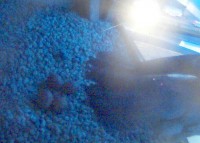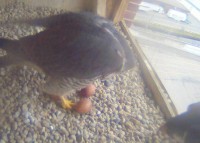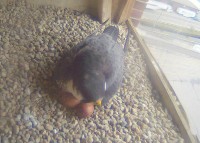Lawrence Peregrines: how incubation works?
April 19, 2018 in In the Nest Box, lawrence peregrines, Peregrine Falcons Eastern Massachusetts, Peregrine Falcons Massachusetts
 The peregrines started the day under overcast skies, wind west at 6MPH, and temp around 43F. Today’s forecast calls rain and snow, becoming all rain after 11am. High near 45. Light and variable wind. Chance of precipitation is 80%. Total daytime snow accumulation of less than a half inch possible. Snow…..AGAIN??
The peregrines started the day under overcast skies, wind west at 6MPH, and temp around 43F. Today’s forecast calls rain and snow, becoming all rain after 11am. High near 45. Light and variable wind. Chance of precipitation is 80%. Total daytime snow accumulation of less than a half inch possible. Snow…..AGAIN??
Had a chance to observe the nest box from just before 5:30 AM today and both adults were in and out of nest box a number of times. The female raised up about 5:40 AM, made a nice stretch of wings and legs, and then departed in south bound direction. Then, the two of them exchanged places a number time before the male finally settled in and remained on the eggs.
 So, just how does incubation work?
So, just how does incubation work?
Heat makes the eggs start developing. When the eggs reach about 98.6°F, or 37°C the egg begins changing into an eyas, or young falcon. Conveniently enough, a peregrine’s natural body temperature is about 103°F, or 39.5°C, so to heat up the eggs all they need to do is to get some of that body heat onto the eggs. Now, a Peregrine’s feathers make very good insulation. That’s how they can stand to stay out in cold temperatures without freezing to death. But while those feathers keep the cold air away from the falcon’s skin, they also keep their body heat from getting out.
 So to incubate the eggs, the peregrine carefully settles down, shifting from side to side to get the eggs beneath their feathers. The male in Lawrence, tends to shift a lot while settling on to the eggs, while the female carefully settles down with minimum fuss. Falcons have brood patches, areas on their breasts with a lot of blood vessels close to the surface of their skin. The blood vessels concentrate their body heat, making it easier to transfer the heat to the eggs. Both adult peregrines have brood patches, though his are smaller than hers, which makes sense since he’s a smaller bird. More on how to tell the difference between male and female in next post!
So to incubate the eggs, the peregrine carefully settles down, shifting from side to side to get the eggs beneath their feathers. The male in Lawrence, tends to shift a lot while settling on to the eggs, while the female carefully settles down with minimum fuss. Falcons have brood patches, areas on their breasts with a lot of blood vessels close to the surface of their skin. The blood vessels concentrate their body heat, making it easier to transfer the heat to the eggs. Both adult peregrines have brood patches, though his are smaller than hers, which makes sense since he’s a smaller bird. More on how to tell the difference between male and female in next post!
Literature cited: Imprints Blog, The Journal of the Rfalconcam, Rochester Falcon Cam. The Genesee Valley Audubon Society is the local chapter of the National Audubon Society in Rochester, NY. GVAS sponsors the Rochester Falconcam (Rfalconcam) as part of their education and awareness programs.
